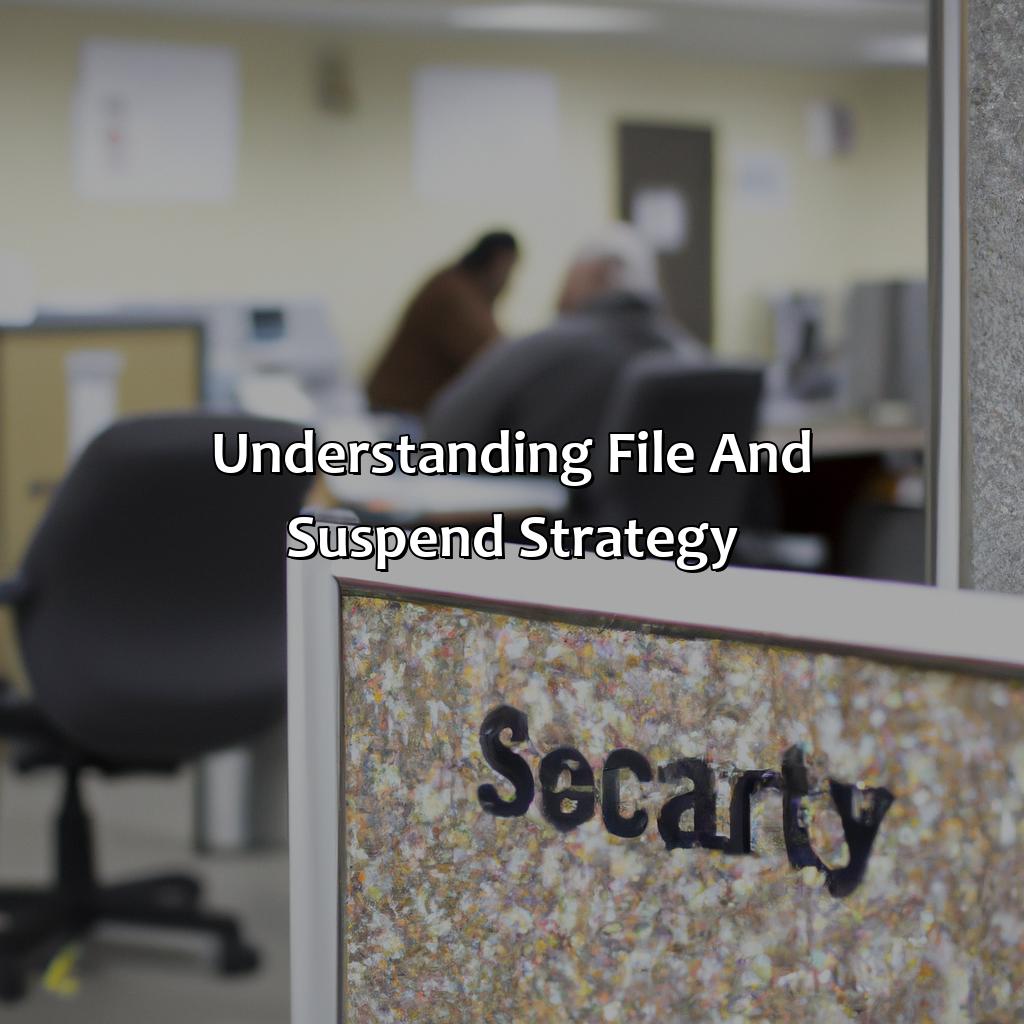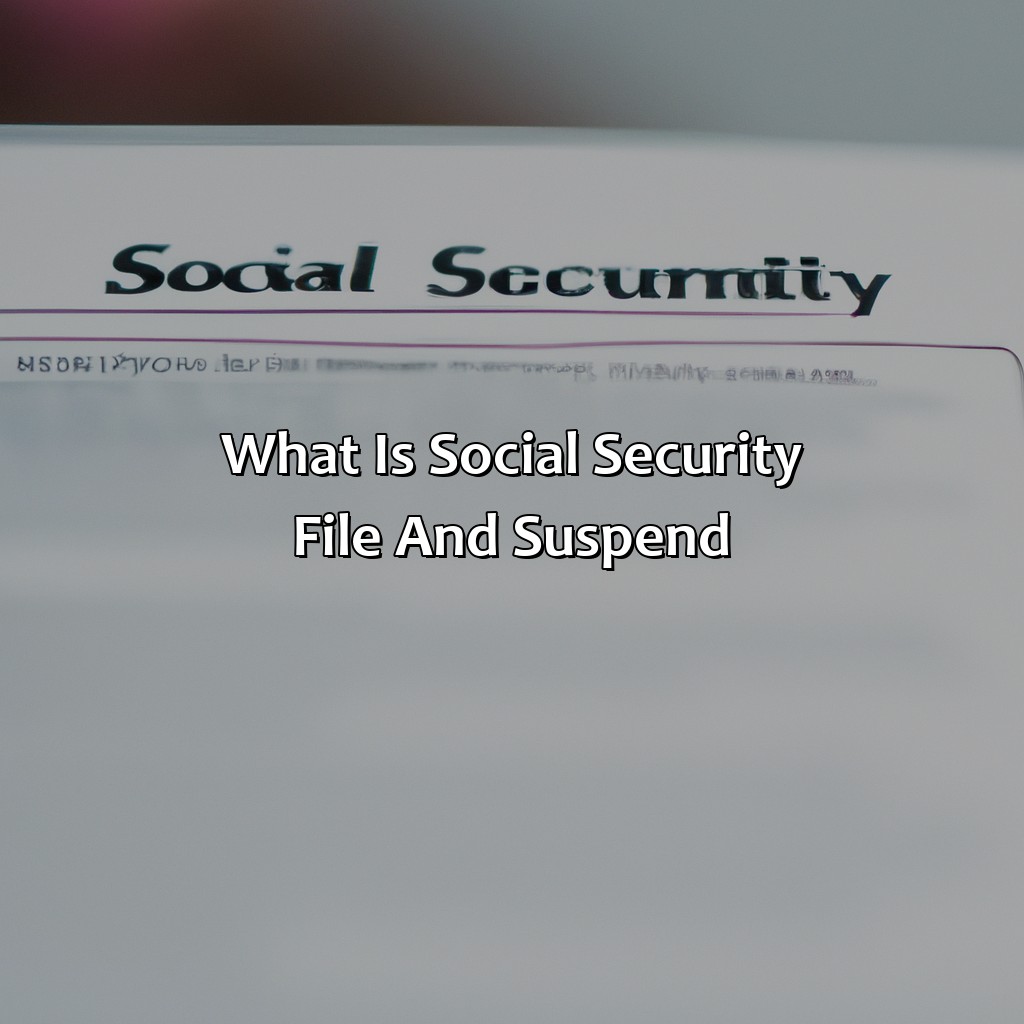What Is Social Security File And Suspend?
Key Takeaway:
- Social Security File and Suspend is a strategy that allows spouses to maximize their Social Security benefits by delaying the collection of benefits.
- File and Suspend can be used for both retirement and spousal benefits, and allows for maximum benefits to be collected at a later date.
- While File and Suspend may be advantageous for some individuals, it is important to weigh the advantages and disadvantages, and consider personal circumstances before deciding whether it is the right strategy for maximizing Social Security benefits.
Do you need help understanding Social Security File and Suspend? This article will clear up the confusion and provide insight into the process and its associated benefits. You will learn how to maximize your Social Security benefits and how to apply for File and Suspend.
What is Social Security File and Suspend?
In the realm of Social Security, File and Suspend is a strategy that allows one spouse to file for benefits but suspend receiving them, while the other receives spousal benefits. This can maximize the amount of Social Security benefits received over time. This strategy is available only to those who have reached full retirement age. It’s important to note that this strategy is being phased out and will no longer be available after April 30, 2016.
To dive into the specifics, the spouse who plans to file and suspend must have reached their full retirement age and be eligible for retirement benefits. Upon filing, the other spouse can then file for spousal benefits, which are based on the retiree’s benefit amount. In doing so, the spouse can receive up to 50% of the retiree’s benefit amount, while the retiree’s own benefit continues to grow until age 70.
It’s worth noting that this strategy may not be beneficial for everyone. It’s important to consult with a financial advisor or Social Security specialist to determine if it’s the right fit for individual circumstances.
While the File and Suspend strategy may no longer be an option for those approaching retirement age, it has had a significant impact on many retirees who were able to maximize their Social Security benefits using this tactic. One example is a retired couple who sought advice from a financial advisor and were able to increase their lifetime benefits by over $100,000 through the use of File and Suspend. It’s important to explore all options when it comes to retirement planning and seek expert advice.

Image credits: retiregenz.com by David Washington
The Basics of Social Security Benefits
Dive into the complexity of social security benefits! Let’s begin by looking at the types of benefits available. Then, we’ll cover the eligibility requirements. With this knowledge, you can make informed decisions about social security. It’s time to get informed!
Steps:
- Look at the types of benefits available.
- Understand the eligibility requirements for each benefit.

Image credits: retiregenz.com by Yuval Duncun
Types of Social Security Benefits
Social Security Benefits are vital resources that guarantee financial stability in later life and disability. The benefits include retirement, survivors, disability, and supplemental security income.
- Retirement benefits provide lifelong payments for retired workers who have made Social Security contributions.
- Survivors’ benefits help family members receive a survivor’s benefit when the wage earner dies.
- Disability benefits provide financial support to people with a medical condition or injury that prevents working.
- Supplemental Security Income provides assistance to disabled adults and children, aged persons with limited income and resources.
It’s essential to know that these different types of Social Security Benefits vary depending on an individual’s situation. Moreover, some factors influence the quantity received as payment, such as earning history recorded by Social Security and age at which one enrolls for benefits.
In 1935, President Roosevelt signed Social Security into law as part of the New Deal in America. However, the provisions have undergone several changes over time through legislative amendments throughout its history.
If you’re not eligible for Social Security benefits, at least you can still use the friendship option on Facebook.
Eligibility Requirements for Social Security Benefits
To be eligible for social security benefits, individuals must meet certain requirements. These include:
- Having earned enough credits through paid work
- Being at least 62 years old or disabled
- Being a US citizen or lawful permanent resident
Additionally, the amount of benefits received is determined by factors such as earnings history and the timing of claiming benefits.
It’s important to note that there are also other eligibility criteria for specific types of benefits offered through social security, such as survivor benefits or spousal benefits. These can vary based on factors such as marital status and age.
According to Forbes, approximately 94% of workers in the US are covered by social security. However, it’s still crucial to fully understand the eligibility requirements to ensure that you can receive the maximum amount of benefits possible.
File and Suspend: Because retiring with a bang is more fun than retiring with a whimper.
Understanding File and Suspend Strategy
To comprehend the file and suspend strategy for social security benefits, explore the article with its sub-sections. Grasp the definition and goal of file and suspend. Also, learn the process to file and suspend social security benefits.

Image credits: retiregenz.com by Joel Woodhock
Definition and Purpose of File and Suspend
File and suspend strategy refers to a social security technique that allows a spouse or an ex-spouse, who has been married for at least ten years, to claim benefits on their partner’s record while the partner delays their own claims. This technique allows the primary claimant to receive higher monthly payments when they eventually start claiming the benefits. By suspending their own benefits, the main wage earner can delay taking social security payments, which can result in increasing their future payouts by as much as 8% per year until the age of 70.
This strategy has significant tax-saving potential and is especially beneficial for couples where one spouse had significantly lower earnings over the course of their career. File and Suspend strategy is only available until April 29th, 2016, when new rules were introduced by government under Budget Act (Bipartisan Budget Act of 2015), after this date Social Security Administration no longer accept any new application for file and suspend policy.
This technique lets one spouse collects spousal benefits while enabling earnings on his/her records grow up til age 70 resulting in higher payouts later on.
Get ready to file, suspend, and let your social security benefits hang loose like a hammock on a sunny day.
How to File and Suspend Social Security Benefits
Learning the Process of Social Security File and Suspend
Are you curious about how to file and suspend your social security? This strategy is a technique that can significantly increase your lifetime benefits. Here, we will guide you through the necessary steps to file and suspend your social security benefits.
Step-by-Step Guide on How to File and Suspend Social Security Benefits:
- Consult with an experienced financial advisor.
- File for retirement benefits at full retirement age (FRA)
- Suspend your claim of benefit.
- Maximize spousal benefits by having your partner claim them under their name.
- Resume collecting your benefits when needed or when it is most lucrative for you in increasing lifetime benefits.
It is essential to understand that filing and suspending only works if both spouses earned significant amounts of work credits to qualify for social security themselves. Understanding these technicalities with the help of a professional financial advisor can make filing and suspending effective.
Pro Tip: Be sure to apply the right strategy at the perfect time to maximize social security claims in a way that’s personalized specifically for your needs.
File and suspend: the ultimate retirement strategy for indecisive procrastinators.
Advantages and Disadvantages of File and Suspend Strategy
Let’s explore the advantages and disadvantages of the file and suspend strategy in social security. Examining the pros and cons can help you decide if this strategy is right for you.
The benefits of this strategy include:
- Ability to maximize Social Security benefits by receiving delayed retirement credits
- Option to allow spouse to receive spousal benefits while waiting to claim their own benefits
- Flexibility in claiming Social Security benefits
The drawbacks of this strategy include:
- Not available to everyone – only those who are full retirement age or older can take advantage of this strategy
- May not be financially feasible if you need to claim Social Security benefits early
- File and suspend strategy may not be available in the future due to changes in Social Security laws and regulations

Image credits: retiregenz.com by James Washington
Advantages of File and Suspend Strategy
Social Security File and Suspend Strategy entails significant advantages to maximize the benefits. It involves filing for Social Security, then suspends it, allowing your spouse or dependents to claim benefits under your record, while still accumulating delayed retirement credits.
- Higher Benefits: The File and Suspend Strategy increases the benefit amount by earning delayed retirement credits, which is 8% per year after full retirement age.
- Spousal Benefits: Your spouse can receive half of your Social Security benefit.
- Survivor Benefits: Spouse and dependent children still receive survivor’s benefits in case of any unforeseen events.
- Tax-Free Income: In case Social Security income was your only source of income, it would be entirely tax-free.
- Flexibility: With more than one way to suspend or resume benefits under this strategy, you remain flexible in terms of managing finances.
- The right to change minds: If the circumstances change within two years of implementing file and suspend strategy, individuals are permitted to withdraw the application timely.
Moreover, this strategy is ideal for married couples where one spouse plans on working beyond full retirement age as it provides financial security and higher lifetime earnings from Social Security.
The opportunity cost of not applying for social security implicates that people could lose out on tens of thousands throughout their lifetimes,which warrants using different types of strategies such as file and suspend.
Don’t miss out on social security benefits by not considering a file-and-suspend strategy which could significantly improve your financial status during retirement. Consult with a professional who can help understand if this strategy suits your interests appropriately.
Sadly, the File and Suspend strategy won’t magically solve all your social security problems, but it will give you more free time to ponder them.
Disadvantages of File and Suspend Strategy
When considering Social Security benefits, individuals may contemplate the drawbacks of utilizing a File and Suspend Strategy. This strategy involves filing for benefits at Full Retirement Age and then immediately suspending those payments, allowing their benefits to continue growing up until age 70. However, despite the potential rewards, there are several downsides to this method.
- Loss of Spousal Benefits: By suspending Social Security payments, spouses may lose access to valuable spousal benefits until the primary earner reactivates their claim.
- Ineligibility for Lump Sum Payment: Individuals who use the File and Suspend Strategy may become ineligible for the lump sum payment option that allows them to receive up to six months’ worth of retroactive payments.
- Dependents Lose Benefits: Children or disabled dependents who rely on Social Security benefits could potentially lose access to those same benefits if the primary earner chooses to suspend payments.
- No Back Pay Available: While individuals can suspend their Social Security benefits anytime after Full Retirement Age in order to increase future monthly payments, they cannot receive any back pay missed during that time.
- Tax Implications: Receiving a larger payout later in life by suspending Social Security payments can also result in larger tax bills if more income is earned during that time.
- Complexities of Implementation: The File and Suspend Strategy requires several complex steps to properly execute and can be challenging for those without experience navigating Social Security’s complexities.
It is important to carefully consider all factors before choosing a File and Suspend Strategy as an option. This includes factors such as personal financial needs, eligibility criteria, tax implications, and complexities involved with implementation. Failing to consider these factors can lead individuals down a path where they miss out on valuable benefits.
Ultimately, seeking guidance from qualified professionals such as financial advisors or lawyers with expertise in Social Security can help clarify uncertainties surrounding such decisions. By taking into account these concerns while utilizing sound advice, one can make an informed decision and choose the best course of action for their unique situation.
Five Facts About Social Security File and Suspend:
- ✅ Social Security File and Suspend was a strategy used to maximize Social Security benefits for married couples. (Source: The Balance)
- ✅ File and Suspend allowed one spouse to claim Social Security benefits while the other spouse deferred their claim to a later date, increasing the payout amount. (Source: Investopedia)
- ✅ The Bipartisan Budget Act of 2015 effectively ended the File and Suspend strategy for most people. (Source: Forbes)
- ✅ File and Suspend is still available for certain individuals who reach age 66 on or before April 29, 2016. (Source: The Motley Fool)
- ✅ It is important to consider all available Social Security strategies and options when planning for retirement. (Source: U.S. News & World Report)
FAQs about What Is Social Security File And Suspend?
What is Social Security file and suspend?
Social Security file and suspend is a strategy that allows a married couple to maximize their Social Security benefits.
How does Social Security file and suspend work?
The spouse who has the higher Social Security benefit reaches full retirement age and files for Social Security benefits but then immediately suspends them. This allows the other spouse to claim spousal benefits and delay their own benefit until a later date, when it will be worth more.
Who is eligible for Social Security file and suspend?
Only those who have reached full retirement age and have filed for Social Security benefits are eligible for file and suspend. Additionally, only married couples are able to take advantage of this strategy.
When should I consider using Social Security file and suspend?
If you are married and plan to take advantage of this strategy, it is best to do so before April 30, 2016. After that date, file and suspend will no longer be an option due to recent changes in Social Security law.
What are the benefits of Social Security file and suspend?
The benefits of Social Security file and suspend include maximizing Social Security benefits for both spouses and potentially increasing total benefits over a lifetime. It also allows the lower-earning spouse to claim spousal benefits while delaying their own benefit, which can help ensure financial security in retirement.
What are the risks of Social Security file and suspend?
The risks of Social Security file and suspend include changes in Social Security law, such as recent changes that eliminate the strategy after April 30, 2016. Additionally, it is important to consider individual circumstances, such as health and financial goals, before deciding to use this strategy.
